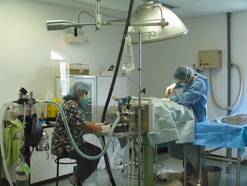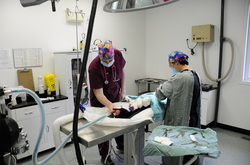Surgical Care

We offer many different surgical procedures at our hospital including spays, neuters, intestinal surgery, cystotomies, wound repairs, tumor removals, eyelid surgery, orthopedic surgery as well as others.
When your pet is admitted to our hospital for surgery, several steps are taken before the actual surgery. Prior to surgery, each patient receives a thorough physical examination to identify any existing medical conditions that might endanger their health. Because not all problems can be detected on examination, we recommend all surgery patients undergo pre-anesthetic blood and urine testing. These tests give us a more complete picture of your pet's health and allow us to tailor an anesthetic regimen that is specific for your pet. If all is well, a technician will administer a pre-anesthetic sedative to reduce pain, calm your pet, and reduce the amount of gas anesthesia needed. Later, after an intravenous catheter has been inserted, a short acting drug is given to allow your pet to fall asleep. At that point, a breathing (tracheal) tube will be placed and a gas anesthesia/oxygen mix will be administered directly into the lungs. We use the same anesthesia as human hospitals.
When your pet is admitted to our hospital for surgery, several steps are taken before the actual surgery. Prior to surgery, each patient receives a thorough physical examination to identify any existing medical conditions that might endanger their health. Because not all problems can be detected on examination, we recommend all surgery patients undergo pre-anesthetic blood and urine testing. These tests give us a more complete picture of your pet's health and allow us to tailor an anesthetic regimen that is specific for your pet. If all is well, a technician will administer a pre-anesthetic sedative to reduce pain, calm your pet, and reduce the amount of gas anesthesia needed. Later, after an intravenous catheter has been inserted, a short acting drug is given to allow your pet to fall asleep. At that point, a breathing (tracheal) tube will be placed and a gas anesthesia/oxygen mix will be administered directly into the lungs. We use the same anesthesia as human hospitals.

We have a doppler monitor for monitoring blood pressure while under anesthetic. Based on our careful monitoring, anesthesia can be adjusted accordingly, and any physiological changes can be detected before serious problems occur. Intravenous fluids will be given both during and after the procedure to maintain blood pressure. A fluid pump regulates the intravenous fluid rate, and the rate will be adjusted with changes in your blood pressure. The intravenous catheter also allows rapid administration of emergency medications if needed. Our surgery is equipped with "The Bair Hugger", a safe and effective surgical warming blanket system. Your pet's surgery site is prepped and scrubbed and surgery is performed in our modern surgery suite with the surgeon and assistant masked and gowned. Your pet is monitored by an attending technician during the procedure and when the surgery is complete, the anesthesia is turned off and oxygen is administered. Your pet continues to be monitored by our trained staff during the recovery period, and is given additional injectable pain management later in the day as needed.